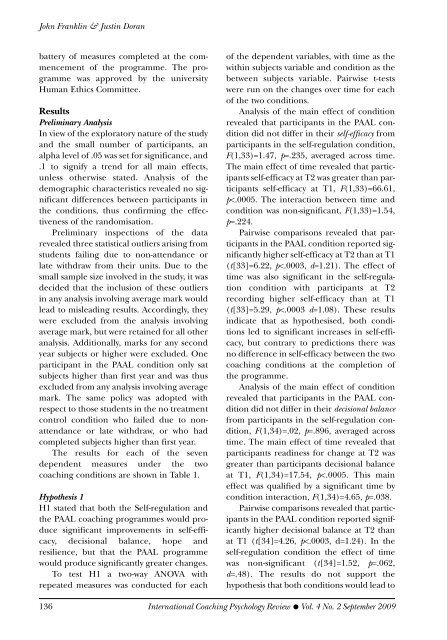International Coaching Psychology Review, 4.2, September 2009
International Coaching Psychology Review, 4.2, September 2009
International Coaching Psychology Review, 4.2, September 2009
You also want an ePaper? Increase the reach of your titles
YUMPU automatically turns print PDFs into web optimized ePapers that Google loves.
John Franklin & Justin Doran<br />
battery of measures completed at the commencement<br />
of the programme. The programme<br />
was approved by the university<br />
Human Ethics Committee.<br />
Results<br />
Preliminary Analysis<br />
In view of the exploratory nature of the study<br />
and the small number of participants, an<br />
alpha level of .05 was set for significance, and<br />
.1 to signify a trend for all main effects,<br />
unless otherwise stated. Analysis of the<br />
demographic characteristics revealed no significant<br />
differences between participants in<br />
the conditions, thus confirming the effectiveness<br />
of the randomisation.<br />
Preliminary inspections of the data<br />
revealed three statistical outliers arising from<br />
students failing due to non-attendance or<br />
late withdraw from their units. Due to the<br />
small sample size involved in the study, it was<br />
decided that the inclusion of these outliers<br />
in any analysis involving average mark would<br />
lead to misleading results. Accordingly, they<br />
were excluded from the analysis involving<br />
average mark, but were retained for all other<br />
analysis. Additionally, marks for any second<br />
year subjects or higher were excluded. One<br />
participant in the PAAL condition only sat<br />
subjects higher than first year and was thus<br />
excluded from any analysis involving average<br />
mark. The same policy was adopted with<br />
respect to those students in the no treatment<br />
control condition who failed due to nonattendance<br />
or late withdraw, or who had<br />
completed subjects higher than first year.<br />
The results for each of the seven<br />
dependent measures under the two<br />
coaching conditions are shown in Table 1.<br />
Hypothesis 1<br />
H1 stated that both the Self-regulation and<br />
the PAAL coaching programmes would produce<br />
significant improvements in self-efficacy,<br />
decisional balance, hope and<br />
resilience, but that the PAAL programme<br />
would produce significantly greater changes.<br />
To test H1 a two-way ANOVA with<br />
repeated measures was conducted for each<br />
of the dependent variables, with time as the<br />
within subjects variable and condition as the<br />
between subjects variable. Pairwise t-tests<br />
were run on the changes over time for each<br />
of the two conditions.<br />
Analysis of the main effect of condition<br />
revealed that participants in the PAAL condition<br />
did not differ in their self-efficacy from<br />
participants in the self-regulation condition,<br />
F(1,33)=1.47, p=.235, averaged across time.<br />
The main effect of time revealed that participants<br />
self-efficacy at T2 was greater than participants<br />
self-efficacy at T1, F(1,33)=66.61,<br />
p

















